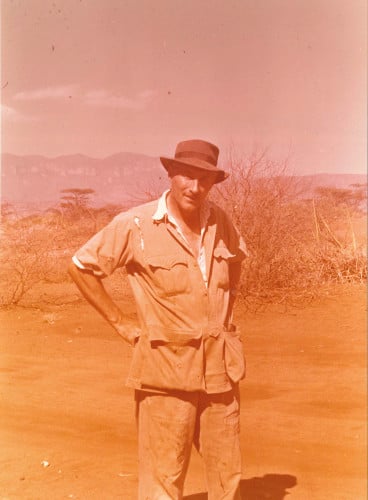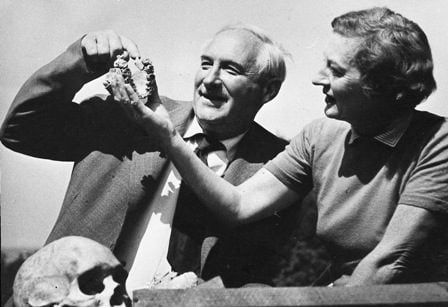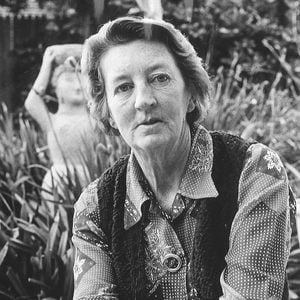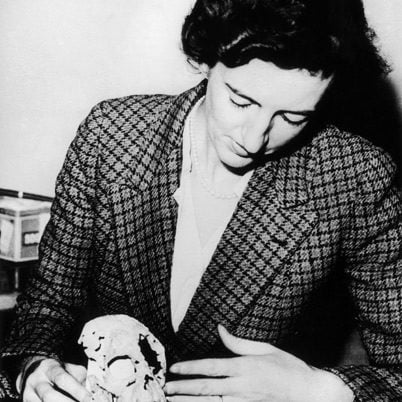Louis Seymour Bazett Leakey

Louis Leakey in Kenya in 1955.
Louis Leakey (b. 1903, d. 1972) was a tireless promoter of the study of human origins. With his theoretical and paleontological work in the field, he had a considerable impact on the science of early human evolution.
In addition to the 20 books and over 150 articles he wrote in his lifetime as well as the multiple fossil and stone tool discoveries that contributed so significantly to our understanding of the field, he was also largely responsible for convincing other scientists that Africa was the key location in which to search for evidence of human origins. In the face of great opposition, he strongly supported Darwin’s assertion that human evolution began in Africa. As it turns out, Leakey’s early, controversial, yet unwavering position that Africa was the cradle of humanity has held up against modern scientific scrutiny and is now universally accepted.
Louis was born on August 7, 1903, at Kabete Mission (near Nairobi) in Kenya, where his parents Harry and Mary (Bazett) Leakey were English missionaries to the Kikuyu tribe. Louis grew up speaking Kikuyu as fluently as English, and at age thirteen he was initiated as a member of the Kikuyu tribe. He later wrote a definitive study of their culture in 1937.
Leakey began his university career at Cambridge University in 1922, but a rugby injury caused him to postpone his studies. He then left to help manage a paleontological expedition to Africa. He graduated with degrees in both anthropology and archaeology in 1926. After completing his degrees, Leakey began leading expeditions to Olduvai, a river gorge in Tanzania, where he found important fossils and Stone Age tools. In 1948 he reported finding a 20-million-year-old skull he named Proconsul africanus on Rusinga Island in Lake Victoria, Kenya. Though now considered to be too specialized to have been a direct ancestor of current ape and human populations, Proconsul is still deemed scientifically valuable as a model for early human ancestors.

Louis and Mary Leakey with the jaw of Zinjanthropus, now known as Paranthopus boisei. Photo by Des Bartlett from The Leakey Foundation archive.
The first significant hominid fossil attributed to Leakey, a robust skull with huge teeth dated to 1.75 million years ago, was found by Louis’ collaborator and second wife Mary Leakey. She found it in deposits that also contained stone tools. Louis claimed it was a human ancestor and called it Zinjanthropus boisei. It is now understood to be a form of Australopithecus. Another important discovery was the 1964 reporting of Homo habilis (named by Louis, Phillip Tobias and John Napier), which Leakey believed was the first member of the actual human genus as well as the first true toolmaker. Though the interpretations of Leakey’s fossil finds were and still are controversial, their significance to the field of human origins is generally acknowledged.
Leakey had a significant effect on not only the field of paleoanthropology but also primatology. He was responsible for initiating Jane Goodall’s long-term field study of chimpanzees in the wild, and he helped obtain and coordinate funding for similar projects such as Dian Fossey’s work with mountain gorillas in Rwanda and Birute Galdikas’ work with orangutans in the Sarawak region of Indonesia.
Always a dynamic and energetic man, Leakey kept up a rigorous schedule of lecturing and fundraising. In 1972, while on route to a speaking engagement in London, Louis Leakey suffered a heart attack and died.
Louis Leakey radically changed the way we now view early humans. Though he always had his detractors, Louis Leakey is considered to be a significant contributor to the understanding of our origins. He pushed back the known dates for the existence of various species, changed phylogenies to include the existence of parallel lines of evolution in the human family, stimulated research in new fields like primatology, and generated interest and publicity for the study of human origins.





